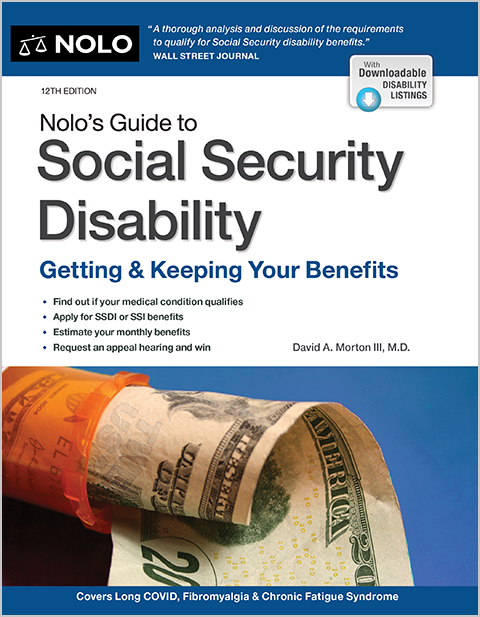A special needs trust can be set up for a Medicaid applicant who is over the resource limit.
Special needs trusts are designed to hold assets that can be used for the benefit of someone who is receiving Medicaid for nursing home or other long-term care (called the "Medicaid beneficiary"). These trusts are sometimes called "special treatment trusts" or "special purpose trusts."
Special needs trusts prevent the Medicaid beneficiary from being disqualified from Medicaid long-term care for being "over-resource"—that is, having too many assets. These trusts can also be used to qualify for Supplemental Security Income (SSI).
The funds in a special needs trust can be used to provide certain amenities to a disabled beneficiary, which is why these trusts are sometimes called supplemental needs trusts. Special purpose trusts are explicitly designed by state and federal statutes so that the beneficiary won't be disqualified or penalized by transferring assets into the trusts, so long as the requirements for establishing and using the trusts are strictly followed. (Note that the transfer penalties don't cause a period of ineligibility for Medicaid-paid home care, but only to nursing and assisted living facilities.)
First-Party Special Needs Trusts
If a Medicaid applicant or beneficiary has resources (assets) in excess of the allowable limit, the applicant or beneficiary can transfer those excess resources to a special needs trust. Since this is a special purpose trust established by federal law, the applicant isn't penalized for transferring assets to this trust (that is, the applicant isn't disqualified from Medicaid), so long as the trust is properly established.
A first-party trust means it consists of the beneficiary's own assets. This trust is sometimes referred to as a self-settled trust or a d4a trust, which refers to the sub-section of the federal law that established it, 42 USC 1396p(d)(4)(a). When someone is already receiving Medicaid, a first-party trust is often used to manage a significant amount of funds received from an inheritance or court settlement.
To qualify for a first-party trust, the following requirements must be met.
- The Medicaid beneficiary must be under the age of 65 and have a disability that meets the Social Security Administration's definition of a disability.
- The trust must be irrevocable (unchangeable).
- If the Medicaid beneficiary is a minor or mentally incapacitated, the trust must be created by a parent, grandparent, guardian, or a court.
- The state paying out benefits must be designated as the primary beneficiary of the trust.
- The assets in the trust may be used only for the benefit of the Medicaid beneficiary.
Each state has very specific guidelines for the use of resources in a first-party special needs trust. Most states require prior approval of expenditures from a special needs trust, and some require that an annual budget be established. Failure to follow state rules will disqualify the trust and disqualify the beneficiary from Medicaid.
Only resources can be placed in a special needs trust. A beneficiary can't place income in a special needs trust. (But keep in mind that once income has been received, it becomes a resource the following month. The month after receipt, the month-old income can be placed in the first-party trust.)
A Medicaid beneficiary's income can be placed only in an income trust for Medicaid qualification purposes—also called a "Miller Trust or Qualifying Income Trust" (see below).
For more information, see Nolo's article on self-settled Medicaid trusts.
Pooled Trusts
Another special purpose trust is a pooled trust (sometimes called a d4c trust). This trust, operated by a nonprofit organization, pools together the resources of many Medicaid beneficiaries, using what is called a "master trust" along with separate "sub-trusts," or "sub-accounts," for each participating beneficiary. The advantage of this trust is that it doesn't have the same requirements as a first-party special needs trust and can be created by a Medicaid beneficiary (or applicant) regardless of age (meaning those over 65 can participate in a pooled trust).
A Medicaid beneficiary or the beneficiary's parent, grandparent, or guardian, or a court can establish a sub-account in a pooled trust.
Upon the death of the Medicaid beneficiary, the state is entitled to reimbursement from the pooled trust for expenses paid on the beneficiary's behalf. Any remaining amount is divided between the charitable organization that created the pooled trust and those designated by the Medicaid beneficiary.
For more information, see Nolo's article on pooled Medicaid trusts.
Third-Party Special Needs Trusts
Unlike the first-party special needs trust, which is created only with the Medicaid beneficiary's own assets, a third-party special needs trust is created with assets of family members or other relatives or friends.
While a third party trust is sometimes referred to as a special treatment trust, it actually isn't designated as such in federal law. In fact, this type of special needs trust isn't created by statute and has none of the statutory requirements found with first-party trusts.
Since these trusts don't contain assets transferred by the beneficiary, but only assets belonging to someone else, the only requirement is that the distribution of trust assets be in the sole discretion of the trustee, and that the trust doesn't allow the beneficiary to demand any type of distribution.
The beneficiary never owns the property in the trust and doesn't have direct access to trust funds. The beneficiary can't receive cash from the trust, and all distributions from the trust must be monitored to make sure that the beneficiary doesn't become ineligible as a result of the distribution (for instance, by owning countable assets over the resource limit).
While the state is the primary beneficiary of a first-party special needs trust, any beneficiary can be established with a third-party special needs trust, and the state has no right of reimbursement from this trust after the Medicaid beneficiary's death. For more information on third-party trusts, see Nolo's section on special needs trusts.
Medicaid Qualifying Trusts
None of the trusts discussed above are "Medicaid qualifying trusts" (MQTs). Medicaid qualifying trusts are trusts established before 1993 that generally cause the beneficiary to be ineligible for Medicaid.
Qualified Income Trusts
Qualified income trusts, also called Miller Trusts or simply income trusts, allow Medicaid applicants in states without a medically needy program to qualify for Medicaid when their monthly income is above the Medicaid limit. The income in the trust is used to pay for the costs of care. For more information, see Nolo's article on using qualified income trusts with Medicaid.
An Alternative to Special Needs Trusts: ABLE Accounts
The Achieving a Better Life Experience Act (ABLE) was passed in 2014 to allow for special bank accounts for individuals with specific disabilities. Money in the accounts doesn't count as an asset for Medicaid, but there are annual contribution limits and a maximum balance. For more information, see Nolo's article on ABLE accounts.


